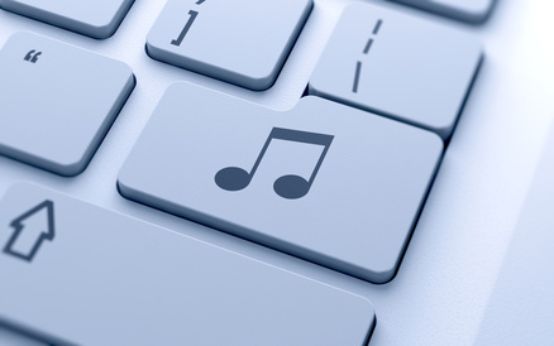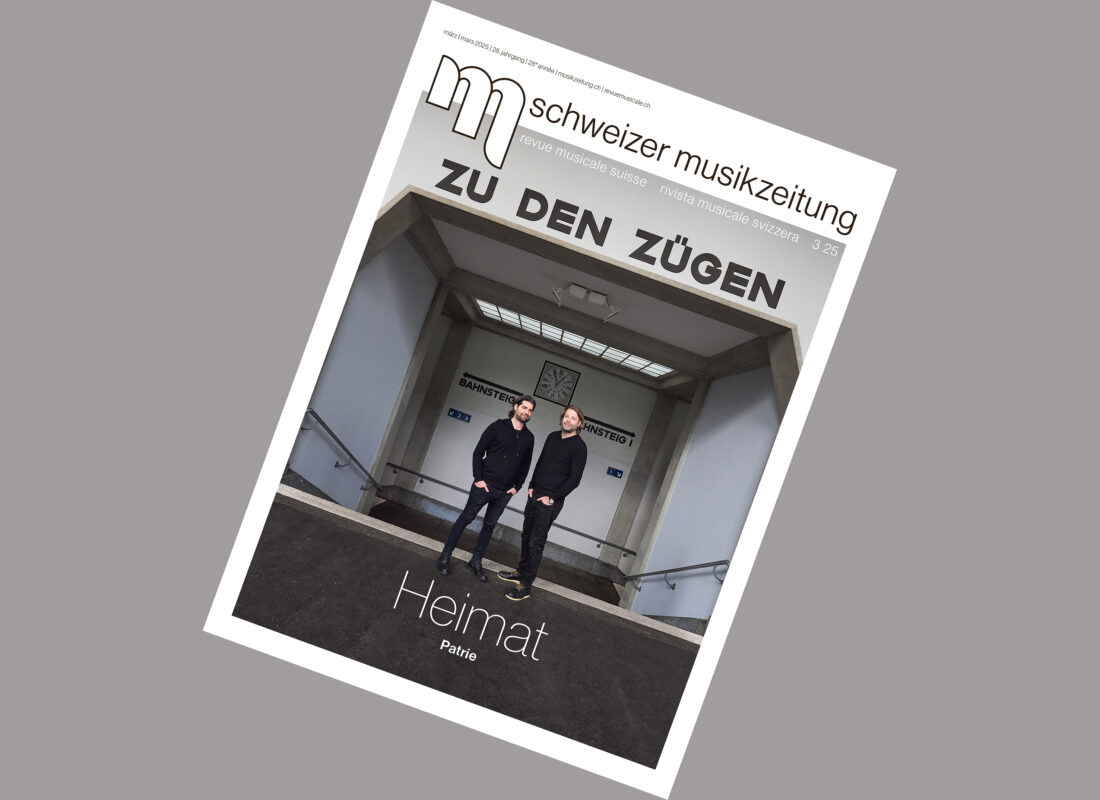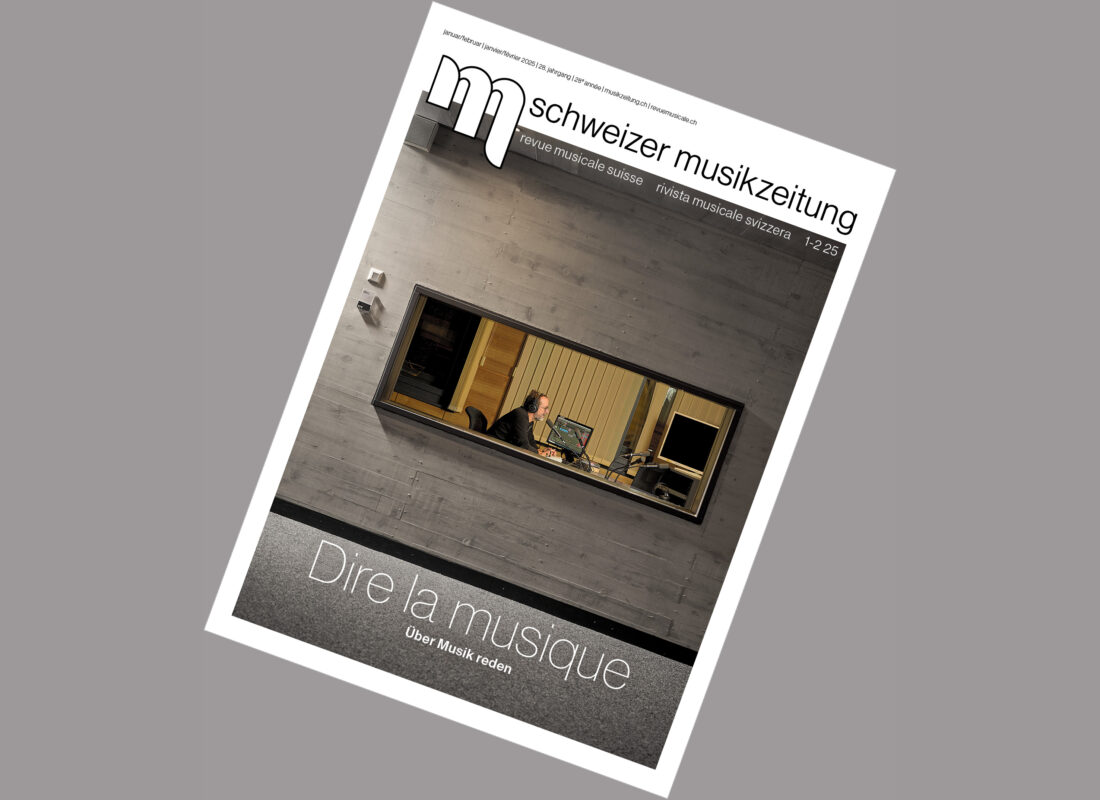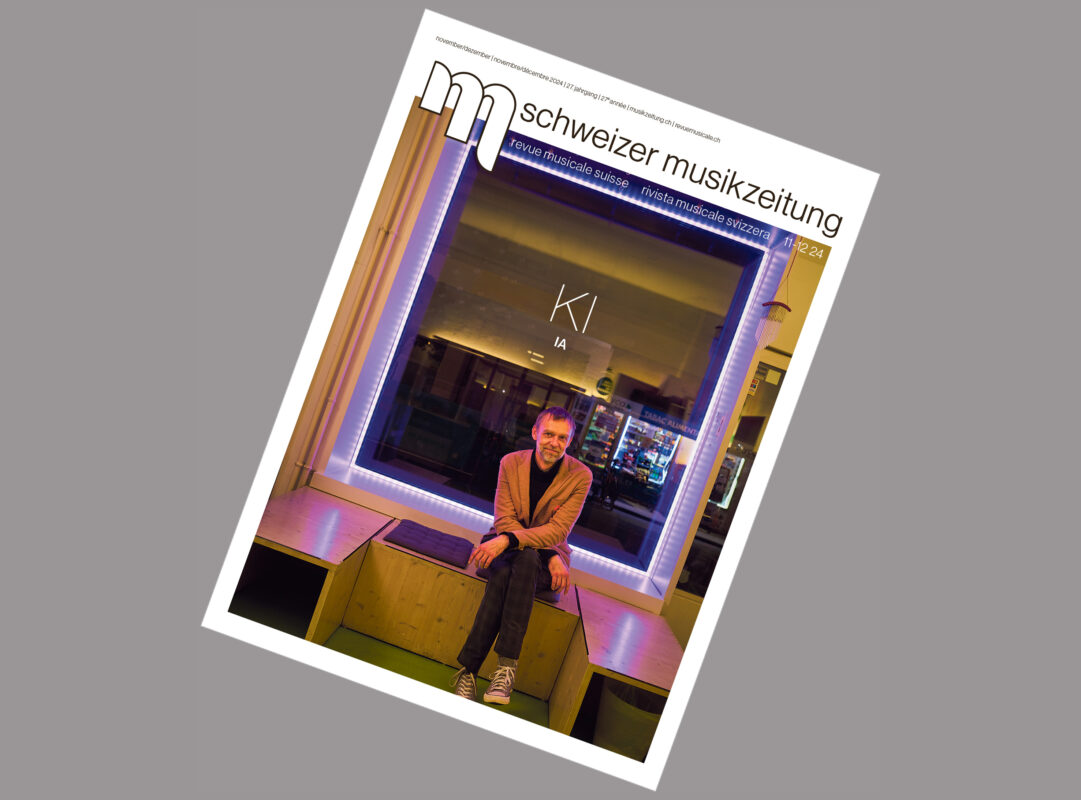Freedom (of choice) that I mean ...
The non-commercial music notation program "MuseScore" and the likewise freely accessible music notation system "Lilypond" are alternatives to the commercial offerings that are worth checking out. An in-depth look at the topic of "Writing sheet music on the computer" and a response to the interview with Marcel Vonesch in the Schweizer Musikzeitung 6/2015.


The non-commercial music notation program "MuseScore" and the likewise freely accessible music notation system "Lilypond" are alternatives to the commercial offerings that are worth checking out. An in-depth look at the topic of "Writing sheet music on the computer" and a response to the interview with Marcel Vonesch in the Schweizer Musikzeitung 6/2015.
Music and computers - this is both a controversial topic and a highly competitive market. It is also a market with special conditions: Musicians' customers are not normally overly tech-savvy, and rightly have no particular interest in swapping their Steinway keyboard for a laptop for days or weeks on end. They simply want a handy tool that allows them to carry out their tasks effectively - which in turn is very demanding from a technical point of view.
The tasks are also as radically different from person to person as the fields of work and working methods. The famous word-of-mouth propaganda is of little help to beginners: praising some favorite software solution has about the same information content as the enthusiastic announcement that the blood pressure-lowering drug XY has achieved wonderful results in one's own case.
What could help to make a well-founded selection, however, would be concrete background information. The fact that I believe I can contribute some comments here is explained by my professional background: Since the early 1990s, I have worked intensively with a wide variety of music-oriented software as a performing musician, music teacher and ensemble leader, but above all as a musicologist and as a designer of music books, and also under various operating systems.
In order to cope with the wide range of tasks, I was almost forced to constantly gain a critical overview of the latest software development solutions. Of course, this also included working with products such as Sibelius, Finale, Capella or their less famous colleagues. However, this also included knowledge and use of free software (more on this in a moment). What craftsman would seriously rely on equipment that promised him a single "super multifunctional all-round tool" to handle all tasks from mowing the lawn to stripping wallpaper to renovating old buildings? ...
Free and free of charge are not the same thing
To correct a common and fatal misunderstanding right from the start: "free software" has very little to do with "free software". "Free" is used here in the sense of "free speech", not "free beer". Free software is subject to a license that allows anyone to use it more or less as they wish (to modify it, rework it, incorporate it in whole or in part elsewhere, but also to give it away, use it for education, study how it works, incorporate it into devices, etc.). The attribute "free" refers primarily to the "source code", i.e. the design instructions written by the programmer, which are ultimately used to automatically produce ("compile") the finished program file. A relatively unimportant side effect is that it naturally makes little sense to sell software that is freely available anyway ...
A program such as the well-known Adobe Reader is free, but by no means "free" - it is "proprietary". This means that only the owner - the company Adobe - has access to the source code and can therefore only modify this software. The finished Adobe Reader can only be copied as it is. In order to adapt it to an operating system update, for example, the source code is essential. (Incidentally, nobody can easily see from the finished program whether it has any unwanted functions apart from the obvious ones - keyword "malware").
The common idea that free software is the domain of bored hobby developers with the urge for self-expression, who temporarily participate in a project in order to then find their real life's work in "real software companies", is a funny caricature - nothing more.
Rather, copyright-free software is a technical necessity in the development of any form of modern software. Since the beginning of the 1990s, software has practically always consisted of a large number of individual modules, some of which are contained in many programs because they provide identical functions. If high-quality software were fundamentally subject to copyright, the development of every new program would have to start from scratch - which would quickly put an end to any software development. In this respect, the source code of practically all purchased programs - music notation or other musical programs are no exception - consists to a certain extent of free software code. It is not without reason that Microsoft, for example, sponsors free software projects with respectable sums of money.
Apart from this, there are large areas in which software is constantly being produced without any sales interests: Universities create special software for a wide variety of subject areas, students, doctoral candidates and post-doctoral students continuously realize software projects. Computer centers, research centers and modern film studios could not work without highly flexible and transparent free software; they regularly contribute modules and bug fixes to free software projects. All this software is, of course, freely available - and, by the way, it's also free ...
It is the openness of the source code alone that allows joint development in developer "communities", some of which are worldwide. It is organized on Internet development platforms and controlled by (freely available) highly specialized database systems. This ensures the quality and compatibility of contributions and enables the main maintainer to exercise effective control. Commercial software companies also work in a similar way.
Incidentally, the often-circulated idea that free software is a necessarily short-lived thing in the absence of the regulatory hand of a company is a rather amateurish notion (albeit one that the advertising drummers of the software industry like to use time and again) that has nothing to do with reality. Today, every Facebook user knows that once things have been immersed in the infinite vastness of the World Wide Web, they are almost impossible to remove - and this also applies to source code. The "expiration date" of free, collaborative projects tends to be even longer than that of many proprietary offerings - logically, they cannot be dragged into the abyss by a collapsing company and are not tied to individual people. Projects such as the professional text typesetting system Latexthe free operating system FreeBSD (which is at the heart of all Apple computers) or the encryption standard PGP have existed since the early days of computer development in the 1970s and early 1980s.
It is therefore hardly surprising that this free, "collaborative" approach also produces music-related software that is absolutely on a par with proprietary software. The main difference to proprietary software is that these projects naturally have no advertising budget.
WYSIWYG and WYGIWYM
Nobody likes to talk about their limitations - and music software manufacturers are no exception. The "WYSIWYG" principle - What You See Is What You Get - is one such quasi-natural limit for music notation programs. Every change should be displayed immediately on the screen with all its effects on the rest of the document. In order to reproduce the keyboard input in a music notation program with a reasonable delay, the entire document has to be calculated and redisplayed on the screen many times per second. This means that the processor only has fractions of a second to set the document.
Now, high-quality music notation is very demanding work. Organizing the details of a score requires incomparably more complex mechanisms: the elements are not arranged like in a text program (Word or similar) are only arranged line by line, but are arranged in complex interrelationships across the page area. The resulting computational effort demands several seconds even from current processors for small staves, and several minutes are not uncommon for larger works. If a WYSIWYG program actually attempted music notation at the level of classical music engraving, the screen content would jump back and forth wildly for the said time after each keystroke or mouse click, while the music text would be inaccessible until the new typesetting image was finally "in place". So there's no question that software like Finale, Sibelius, Capella or MuseScore has to take a different path here: it has to leave it at a relatively rough estimate and, like text programs, work practically exclusively line by line (with carelessness to which we have unfortunately become accustomed due to the ubiquity of these prints). The sophisticated graphics of the characters used and a careful selection of the compromises made ensure an aesthetically pleasing image on the surface. On closer inspection, however, the use of space, for example, is always significantly worse than with actual high-quality music typesetting. In my experience, 6 pages of manual typesetting with the same character size correspond to between 8 and 12 pages of any WYSIWYG typesetting. In other words, there are significantly more and poorly positioned turning points, a less reader-friendly distribution of score details on the page, plus a multitude of micro-typographical sins that are usually only noticed in direct comparison with hand-set "originals". Mind you, this is not about aesthetics, but above all about readability and thus, for example, reducing sources of error during performance!
Unfortunately, you can't have both at the same time: WYSIWYG speed and professional layout (as emphatically as the software advertising may claim). The music notation system Lilypond (as well as the related, less common system MusiXTeX) must therefore take a completely different approach in order to at least come close to the classic standard of music engraving: The notes are initially entered in the form of a kind of to-do list, a simple text file, which the program later uses to calculate the finished typeset - applying the typographical rules of classical music engraving. At the touch of a button, this list is converted into any suitable output format such as .pdf (which then takes a coffee break). This approach is commonly referred to as "WYGIWYM": What You Get Is What You Meant - you get what you meant. The result is, in fact, a practically flawless typeface and at the same time a minimal number of scores. Interestingly, with Lilypond-material actually reduces the error rate of the ensembles that I equip with it - for the sake of better readability.
However, the high typographical quality of the Lilypond-sentences requires some familiarization - in my experience, the entry hurdle corresponds roughly to what Sibelius or Final at the beginning. But don't worry: because Lilypond is developed by musicians for musicians, the thinking behind the program basically corresponds to the usual musical concepts. And since Lilypond is of great importance in the musicological environment, there is hardly a special case imaginable for which solutions have not already been developed. For beginners, there is a methodically very well-made series of learning videos that make the first steps easier (youtube: lilypond tutorial 1 to 25), plus an introductory learning manual and a reference book for special cases (see for all information lilypond.org). A rather cleverly designed input interface called Frescobaldi also makes the work much easier. Complicated and extensive scores nevertheless occasionally require lengthy error correction. On the other hand, text underlay, printing of individual parts or excerpts and output in all kinds of useful formats are solved with unsurpassed elegance (and, for the typesetting professional, direct cooperation with the Latex typesetting system is provided). In addition, a number of functions are available that would be almost impossible to implement with WYSIWYG programs. Because Lilypond-files are simple text files, even large works only take up a few kilobytes, and it doesn't matter under which operating system and with which text editor they are edited (which, if desired, includes all the tools of the usual text program for working on Lilypond-documents).
Intuitive operation
In order not to shoot at sparrows with cannons unnecessarily, I use parallel as a "musical notepad" MuseScore, also a free (WYSIWYG) program, which differs in its current version from the current versions of Sibelius and Final differs marginally at best (Download and all necessary information: musescore.org - where there is also a series of very helpful introductory videos). Apart from all the technical manipulations and extensive customizability of all score details that the commercial programs also offer, the free MuseScore The program naturally imports a wide range of formats - 22 in number, including some proprietary formats, plus an (experimental) scan function for reading music text and back-translation of pdf files into editable/playable music notation files. This means that there is no difference to proprietary programs for the further processing of specified midi files (e.g. from the Petrucci Project IMSLP or related portals). Experience has shown that the pragmatic structure and extensive layout templates make it easy to get started without too many drops of sweat and frustration.
Using the free standard format .xml, the exchange with Finale, Sibelius, Capella, Forte or Overture-users just as easily as the exchange of these proprietary programs with each other, and export to all common sound and graphic formats is possible in the same way as convenient import via keyboard - to name just the most important details.
As far as the sound output (sequencer function) is concerned, the possibilities are not noticeably different: Instrumental and vocal sounds can be assigned to the staves as desired and changed with a click, the sound packages (sound fonts) used can be exchanged at will with a click of the mouse, all sounds can be changed as desired in terms of volume, room acoustics and intonation, a metronome can be switched on automatically for practice purposes, dynamics and all common repetition signs are reproduced as well as various rhythmic inegalizations or effects such as string tremolos. The output as a midi or audio file or as any graphic then allows seamless further processing with any program. As with the other programs, a constantly growing collection of auxiliary functions (plug-ins) is available for special requests and educational purposes. Online storage is available for editing on several computers or for working in groups.
Of particular interest (e.g. for my editorial work), however, is the close connection to Lilypond: MuseScore-files can be opened after Lilypond and further process it there, so that you can get "the chunk and the cherry" with justifiable post-processing effort: intuitive, uncomplicated note input plus flexible sound output (MuseScore), followed by perfect typesetting quality (Lilypond).
Thanks to the free license of both systems, it is therefore not a question of whether you want to use notation à la MuseScore - Sibelius - Finale - Capella or whether you need to invest the intellectual effort of Lilypond/Frescobaldi would like to do.
So test he who binds himself forever ...
A danger that not only Sibelius, Finale or Capella-Finally, we must not forget to mention the risks to which users are exposed. Anyone who uses programs "protected" by copyright unintentionally runs the risk that their program will no longer be installable when the supply of updates ends. It is the rule rather than the exception that an update becomes necessary at the latest after a version change of the operating system. If this is not the case, for example because the manufacturer no longer exists or has switched production, installation is no longer possible. This means that all data created with this program is no longer accessible: logically, it cannot be read or edited by other programs. The common name for this situation is Vendor lock-in (vendor lock-in). Vendor lock-in is anything but a theoretical danger: in my work with proprietary software, it has repeatedly caused me to irreparably lose considerable parts of my work, and the consequences of vendor lock-in are now threatening large areas of public administration.
A first brief look at the Wikipediathat the manufacturing companies of the two top dogs Sibelius (Avid Technology, Inc./USA) and Final (manufacturer: MakeMusic/USA) have been in serious financial difficulties since around 2012. There is therefore no guarantee today that the programs will be developed further after a conceivable restructuring or (partial) sale - unfortunately, music writing software is a relatively unprofitable niche product with high development costs. Since the source code of these programs is of course subject to copyright, it is inevitably lost in the worst case.
But you don't even have to think that pessimistically: it's enough to switch to another manufacturer's program in the future to find yourself standing in front of closed doors for your own older scores after a while.
If, on the other hand, the main developers of a free program stop their work, nothing changes. The source code is still available on one of the free platforms and can be easily updated and further developed by the interested community (which is the rule almost without exception). In the hypothetical case that all interest in a piece of software should suddenly end worldwide, the last version of the source code would still be available, so the program can in principle be restored at any time. In addition, the unencrypted text of free music files can be read or converted by other programs at any time.
Conclusio
I am by no means trying to "convert" anyone to restriction-free software - what would I gain from that? I am merely of the opinion that any responsible decision requires knowledge of all the key factors. Looking through the industry's advertising glasses is at best one of the possible perspectives, and enthusiastic recommendations from colleagues say more about their needs than about your own.
However, the facts described above give rise to a number of consequences and considerations:
- If you are a beginner looking for a suitable music notation program (not: music notation program!), it makes sense to start with the free MuseScore (which, unlike its proprietary sister programs, is also available for all common operating systems). For actual music typesetting, he may want to use the MuseScore and Lilypond/Frescobaldi try it out from time to time. If they still miss functions that are important to them, they are still free to use proprietary solutions. But in this case, he knows much more precisely what he wants and needs. And they have the security of being able to access the documents they have already created at any time.
- Of course, anyone is free to purchase a prestigious commercial program and enjoy an elaborately animated, stylish user interface. However, anyone who works with pupils, students, course participants or other learners must ask themselves whether they can justify involuntarily engaging in social selection by committing themselves to expensive commercial software when there are in fact equivalent free solutions available. Is it also right to make pupils or students permanently dependent on paid updates by opting for a purchased program, without which they would sooner or later be denied access to their own work?
- If the reason for the preference for commercial programs was the popular formula "That's what everyone does!" ("That's just the standard!") or, worse, ignorance of alternatives, this would speak for anything but diligence and professional ethics ...
Voilà: The information is on the street (of the Internet). "Tolle lege" - "Take and read!"says Augustine.
In more modern terms: Google and get informed!
Contact: joerg.fiedler@bluewin.ch
More detailed information
Musescore: https://musescore.org
Musescore is currently available in version 2.0 in versions for all common operating systems. The homepage offers introductory videos, a manual as a pdf download and a 387-page textbook as a fee-based book.
Lilypond: http://lilypond.org
Lilypond is also available for all common operating systems. The current version is 2.18.2http://www.lilypond.org/manuals.de.html
offers an introductory manual, a reference and a developer manual as well as a comprehensive collection of "snippets", small typesetting examples for a wide variety of problem solutions, plus in-depth texts on the background to music typography.
Lilypond tutorial
under this search term on youtube
A collection of less common free music software developments:
http://icking-music-archive.org/software/htdocs/index.html
Basic information about free software
(Keywords for Wikipedia - which is itself an example of free software):
– Comparison of BSD operating systems
– GNU General Public License
– BSD license
– Free Software
– Open Source








